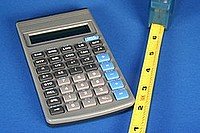|
How Much Flooring Do You Need?
Before starting out on your shopping spree, be sure you know how much flooring you need to purchase. This is especially true if you are planning to install it yourself. If you are planning to purchase materials online, check to see if there is a return policy with the vendor. It makes sense to order more than even the standard 10 - 15% overage if they will allow you to return unopened cases.
Drafting Your RoomThe best way to calculate quantities is to layout your room. This task is made easy with the following basic tools and supplies.
With these tools, you will be able to layout your room effortlessly even if it is an irregular shape. Use one sheet of graph paper for each room so you will be able to make comments and notes on them as you shop. For square and rectangular rooms, count the squares on the graph paper to achieve the length and width. Each square counts as 1 foot. Note: If you end up with a feet and inches measurement, just cut the square up into 4 equal spaces. Each of these represents 3 inch increments and that should get you close enough to approximate the size. Basic CalculationsSince most flooring material is sold by the square foot, it is easy to calculate once you have drawn out your room. The square footage of a room is calculated simply by multiplying the width times the length. For example: If you have a room that is 15 feet wide and 19 feet long, you would multiply the two numbers (15 x 19 = 285) to get 285 square feet. Square footage is often abbreviated as sf or s.f. One exception to the square foot rule is carpet. Carpet is generally calculated in square yards (sy or s.y.). A square yard equals 9 square feet. So to calculate the square yardage required simply find the square footage and divide by 9. 15 x 19 = 285 sf and then 285/9 = 31.66 sy Waste FactorsWhen calculating the final amount required to complete your flooring installation, you should speak to the supplier about what waste factor to figure in. This amount varies by the material and type of installation you are planning. For instance if laying natural hardwoods, you will need to figure much more waste if you are laying the floor on the diagonal vs. a standard installation. Stone tiles are usually bought in lots. If you do not calculate enough waste and have to return to the store, you may not be able to get the same exact color. Most flooring stores will let you return unopened cartons. So be sure to check and then order enough extra so that you are not put into a situation where you can't match lots. As mentioned above be sure to check with online vendors to see what their return policy is. Return From Calculating Quantities to Flooring
|
